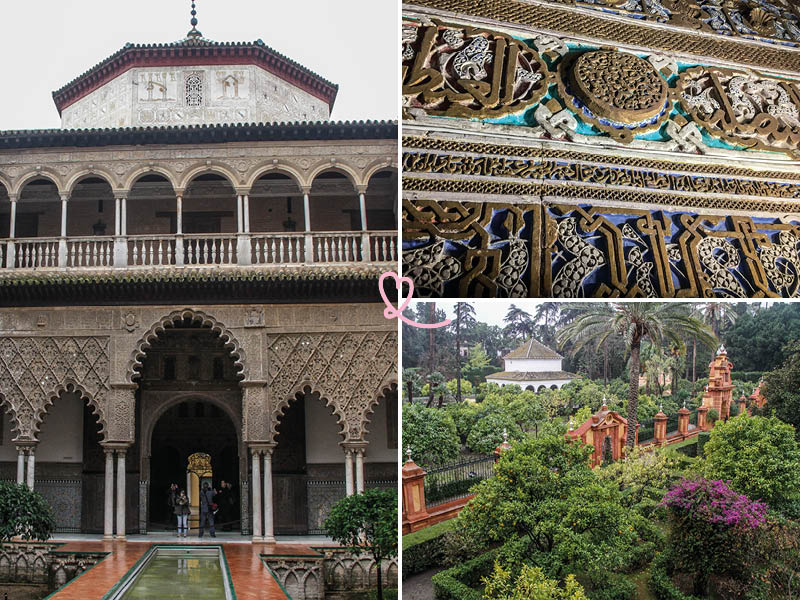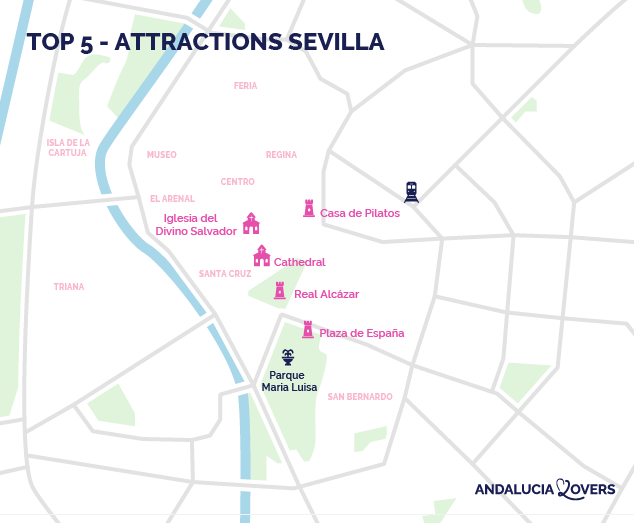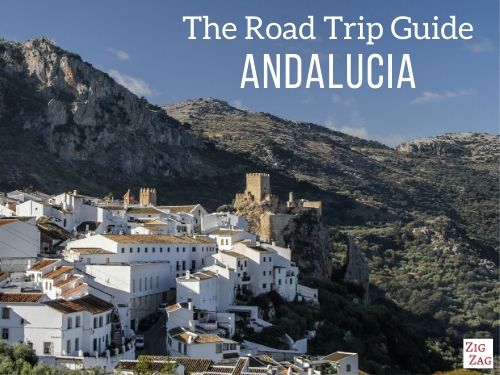The Alcázar is a must-see in Sevilla! This complex of palaces and patios has been a World Heritage Site since 1987. We were seduced by the eclectic styles on display. Indeed, many kings have lived here, from the Umayyad caliphs (10th century) to the Catholic Monarchs. It is to them that we owe the Mudéjar style inspired by Islamic art, which made the Alcázar famous. All this is complemented by superb gardens!
In this article, you’ll find some useful tips to help you prepare for your visit and have a wonderful time!

This opinion is completely independent, based on our experiences. We made our own choices, visited the area anonymously, and paid our bills in full.
Why visit the Alcázar?
Is the palace worth it? Our opinion:
Yes, we think the Alcázar is well worth a visit! Even though the site is very busy, it’s so large that the visit remains pleasant. We really appreciated the grandiose Mudejar style to be found in this palatial complex. We were stunned by the beauty of the azulejos and ornaments! The gardens, with their fountains, lush vegetation and palm trees, are also a delight to visit. It’s one of the best things to do in Sevilla!

Why is the Alcázar famous?
The Alcázar is famous as a masterpiece of Mudejar architecture. When King Pedro I took Sevilla as his capital, he enlisted the help of his ally Mohammed V, reigning in Granada, to build his palace. The best craftsmen from Toledo and Granada flocked to create this sublime palace! The complex is also famous for being the residence of Isabel the Catholic and Charles V. It was here that Christopher Columbus and Magellan came to seek funding for their expeditions! Since 1931, the Spanish crown has no longer owned the palace complex. However, it is in the “cuarto real alto” (upstairs royal apartments) that the royal family stays when they visit Sevilla.

Our favorite moments
You’ll find out more about our visit, but we can’t resist sharing our favorites with you right now:
- Cour des Demoiselles: this magnificent courtyard framing a small garden features superb Mudejar ornamentation and an elegant Renaissance-style gallery.
- The Ambassadors’ Room: this is the room that impressed us most, and with good reason! This was Peter I’s throne room, the most lavishly decorated in the palace, with a grandiose dome.
- The gardens and the Grotesque Gallery: we loved strolling through the palace’s lush gardens, and especially through this gallery, which offers beautiful panoramic views of the palace complex.

WHERE TO STAY IN Seville
Option 1: In the historic center
Convenient for visiting everything on foot, we recommend:

Option 2: El Arenal
Between quiet streets and riverside ambience, we recommend it:

See our complete selection of the best hotels and neighborhoods in Sevilla
History in brief
The Alcázar’s history is closely linked to that of Sevilla. In 711 AD, the Iberian Peninsula was conquered by the Arabs. In the 11th century, the Muslim king had a fortress built. A royal residence and a place of administrative power, the castle also protected the banks of the Guadalquivir until it was reconquered by Ferdinand III in the 12th century. Although vestiges of the Almohad castle are still visible (stucco courtyard, walls…), the king destroyed it to build a Gothic-style palace. You’ll see some of these features on the tour, but they themselves have been modified over the centuries by successive rulers, with Renaissance, Baroque and even Romantic additions! We were particularly impressed by the 14th-century Palace of Peter I, strongly inspired by the Alhambra in Granada and Islamic art. In 1931, the Alcázar was ceded to the municipality of Sevilla by the Crown of Spain, but the royal family still stays here when visiting Andalucia.

Access: Real Alcázar, Sevilla
Where is the Alcázar?
- Downtown Sevilla (Santa Cruz district)
- Patio de Banderas, s/n. 41004 – Sevilla
- 5min walk from the cathedral and 10min from Plaza de España.
Here is a map to help you find your way:

RENT A CAR IN Andalucia
- Compare prices on our preferred platform: DiscoverCars – one of the best rated sites.
- Choose a compact car, as some villages have very narrow streets!
- Think ofcomprehensive insurance for the same reason
- Book early for choice.

How to get there?
The Alcázar is located in the heart of Sevilla. It’s easy to get to, as the historic center is within walking distance. The Puerta de Jerez metro and Archivo de Indias streetcar stops are a five-minute walk from the Real Alcázar. To plan your route, visit the official public transport website here.

Parking
Parking in Sevilla is difficult. We advise you to opt for a paid underground parking lot. The Avenida Roma and Paseo de Christina parking lots are a 10-minute walk from the Real Alcázar.
VISIT Seville
- Things to do in Sevilla
- Best hotels in Sevilla
- Best restaurants
- Best museums
- Excursions from Sevilla
- Visit the cathedral
- Visit the Alcazaba
- Itineraries: 1 day – 2 days – 3 days – 5 days – 1 week (coming soon)
Useful tips: duration, schedules, eating…
Best time to visit
As the palace complex is very busy, we advise you to book your entrance ticket several months in advance. In high season, there can be long queues in front of the monument. We advise you to choose afternoon hours (2pm-3pm). They are less popular with tourists, who fear the heat and prefer to visit the building in the morning. To be sure of a peaceful visit, we recommend that you visit Sevilla in winter!

Length of visit and main difficulties
Allow at least half a day to visit the palace complex and its gardens. Part of the site is accessible to people with reduced mobility. Only the accesses to the Real Cuarto Alto and the Grotesque Gallery have staircases. However, there are occasional cobblestones and uneven floors.

Advice on how to visit
Entrance is via the Puerta del León. There is no set route. However, we recommend you start by visiting the Palacio del Yeso and the Patio del Crucero, the remains of the Almohad fortress. Then explore the Gothic palace. Continue your tour with the Casa de la Contratación and the Casa del Assistente. Why not continue with the highlight of the tour, the Mudejar palace of Pedro I? We ended our visit with a stroll through the magnificent gardens.

PLAN YOUR DREAM TRIP TO andalucia
All the information you need for your trip:
- 7 maps that make planning easier
- + 150 pre-selected locations
- Practical advice
- 300+ photos to help you choose

Visiting with children
If you’re a Spanish-speaking family, you can find child-friendly tour booklets on the official website here.
Schedules and rates
The Real Alcázar is open daily from 9.30am to 5pm (October 1 to March 31) and from 9.30am to 7pm (April 1 to September 30).
Here are the prices:
- Full price: €14.50
- Reduced rate (pensioners over 65, students): €7
- Supplement to visit the Real Cuarto Alto: €5.50
For the latest timetables and fares, and to see who is eligible for the reduced fare, visit the official website here.

Guided tours
Dramatized tours or guided tours for Sevilla residents are sometimes organized. See the official box office here for details.
You can also book a general guided tour with an all-inclusive ticket.

Catering
Inside the palace complex, you’ll find a cafeteria overlooking the gardens. For a more substantial meal, take advantage of the many good addresses nearby. We’ve listed them in our article on Sevilla’s best restaurants. If you’re looking for a leafy setting in the evening, you can head to Patio de Pali, a 5-minute walk from the palace.

From Almohad fortress to Gothic palace
The remains of the Almohad Palace
Construction of a fortress on the Alcázar’s present site began under the Abbadids in the 11th century. Sevilla became the center of power in Al-Andalus, just as the Caliphate of Cordoba had been abolished. The defensive walls and towers that you can see at the entrance to the Alcázar date from this period. But it’s the arches inside the palace that really caught our eye. We found that these Almohad remains blended in well with the other later elements of the palace. In any case, the defensive walls and towers reveal the political instability of the time.

On your left, you’ll come across the Cour des Stucs. Built at the end of the 12th century, it is the main vestige of the Almohad palace, along with the neighboring justice hall. This courtyard measures 170 square meters with its gallery. We particularly liked the portico ornamentation, with its openwork sections letting the light through. Just imagine the importance of this courtyard, around which domestic life was organized. In the center, the pool is connected to a fountain in the courtroom, helping to regulate temperature. Once inside the courtroom, you’ll see delicate ornamentation. They are Mudejar in style, dating from the middle of the 14th century! King Alfonso XI rebuilt the room to celebrate his victory over the Muslim Merinid tribe.

Gothic additions by the first Catholic Monarchs
In 1248, the Catholic king Ferdinand III of Castile conquered Sevilla. He moved into the Alcázar, abandoned by the last Almohad caliph. His heir, Alfonso X, destroyed the Almohad palace. A Gothic residence was built on the foundations. You’ll quickly notice the difference between these rooms and the remains of the Muslim fortress. While Muslim rulers preferred small, intimate rooms, Christian monarchs opted for high, spacious halls. This was particularly noticeable in the vaulted room. You’ll see high ceilings with ribbed vaults typical of Gothic art. Although these rooms are Gothic in style, they were renovated in the 16th century, which explains the presence of Renaissance and Baroque elements (azulejos with mythological representations…).

The splendors of Peter I’s Mudejar palace
The facade and courtyards
After passing through the Almohad wall, we find ourselves in the palace’s main courtyard: the Hunting Court. It’s the ideal place to admire the facade of Peter I’s palace, built in the second half of the 14th century. Fascinated by Islamic art, the king surrounded himself with Granada’s finest Muslim craftsmen to decorate his palace in the Mudejar style (a synthesis of Christian, Muslim and Jewish influences). Take time to admire the plant ornamentation above the main door, on the column capitals and on the arcatures. Can you spot the coats of arms hidden on the façade? We managed to find a lion, symbol of the royal power of Castile and Leon!

The organization of the palace is also inspired by Islamic tradition. It is organized around two courses. The 1st is, in our opinion, the most impressive. The Cour des Demoiselles served the rooms devoted to the king’s public activities. We found it very refined, with its central pool and gardens. The first floor gallery is enhanced by superb Mudejar ornamentation and topped by a Renaissance gallery. Don’t forget to look up, as the gallery’s ceiling is covered with beautiful colored coffers. In the same way, we were charmed by the predominantly blue mosaics that adorn the lower part of the walls. The second courtyard, the Cour des Poupées, is much smaller. It was reserved for the monarch and his family and features magnificent Mudejar decorations.

The royal halls
The rooms surrounding the Cour des Demoiselles are grandiose. We fell in love with the most famous of them all, the Ambassadors’ Hall. It was the throne room of Peter I, which is why the richness of its decor is breathtaking! This was the main room of the palace, where official receptions were held. Look up to admire the splendid gilded wooden dome, which evokes the celestial world. Can you spot the 12-pointed star-shaped keystone? You’ll also find the coats of arms of Castilla y León. Then admire the walls, completely covered with plinths of azulejos and polychrome stuccos featuring inscriptions to the glory of the king and Allah, and plant motifs.

After wandering through the rooms adjoining the Ambassadors’ Hall, you’ll reach the Royal Chamber, adjacent to the Cour des Demoiselles. It comprises two rooms of different sizes. The first space is a bedroom bathed in light thanks to the windows. The second, accessed via three arches, is the summer alcove, i.e. the room used in summer for shelter from the sun. We found this part of the palace very luxurious, with its numerous ornaments composed of plant and geometric motifs interspersed with Arabic inscriptions. As you can see, this tour of the Mudejar palace is our favorite part of the visit!

Renaissance, Baroque and Romantic renovations
Casa de Contratación and Casa del Asistente
We mentioned earlier that the Gothic palace had been renovated with Renaissance and Baroque elements. This is also true of the hunting court, which became the center of the Alcázar in the 14th century. In the 16th century, the Casa de la Contratación, an outbuilding of the palace, played a crucial role in regulating trade with the Spanish colonies in America. We tried to imagine Christopher Columbus coming here to ask for funding for his expeditions! Don’t miss the 18th-century Casa del Asistente. It was occupied by the assistant or mayor of Sevilla, Pablo de Olavide. Although this space is very modest and contrasts with the palace’s other lavish decorations, it is elegant and features showcases displaying beautiful fans and azulejos.

From the chapter house to Maria Padilla’s baths
Still in the Casa de la Contratación area, we were seduced by the chapter house. This is the room where navigators and geographers held their meetings. Raise your head to admire its inlaid ceiling adorned with geometric and floral details. Don’t miss the magnificent altarpiece of the Virgin of the Navigators in the center, which is the first work of religious art relating to the conquest of America. It shows boats from the Spanish fleet. This Gothic-Renaissance polyptych was created in 1535 by the artist Alejo Fernández. The walls feature coats of arms of Castilian admirals, including Christopher Columbus.

Before visiting the gardens, stop off at the Maria Padilla Baths. Following an earthquake in 1755, the lower level of the Cour de la Croix uncovered an underground gallery. It consists of ancient baths and the rib vaults with which Alfonso X had the Almohad structure reinforced at the end of the 13th century. The entrance to this space, which we found very surprising, is in the Jardin de la Danse.

Magnificent gardens
16th- and 17th-century gardens
As early as the Almohad era, green spaces lined the palace. Composed of aromatic herbs, flowers and basins, they activated sensory pleasure and created a setting conducive to meditation. Numerous renovations carried out between the 17th and 20th centuries adapted these spaces to European fashion. In the 17th century, the Italian Vermondo Resta laid out the gardens in Mannerist style, as can be seen from the brightly-colored gallery bearing his name.

But it’s the Grotesque gallery in the pond garden that really stood out for us. Its rough-cut and rock-cut stones give it a very distinctive look. In any case, it offers superb views of the gardens, including the Charles V pavilion, an oratory in Muslim times. In all the gardens, but especially in the Dance Garden, you’ll see superb azulejos, forming low walls or benches. In our opinion, they are in perfect harmony with the lush, exotic vegetation of this space.

The new gardens
Contrary to popular belief, some of the Alcázar’s gardens are quite recent. The 20th century was a period of restoration for the palace complex. At the turn of the century, for example, King Alfonso XIII had this Gothic gateway installed on the palace of the Dukes of Arcos in Marchena, to provide a sumptuous entrance to a new garden: that of Vega Inclán. This marquis was a great patron of Sevilla. The garden in his honor is the largest in the Alcázar, covering 16 hectares. It is influenced by French landscape architecture, while retaining Andalucia elements (canals, fountains, azulejo-covered benches, etc.).

The new gardens also include the Jardin des Poètes and the Jardin Anglais. The latter was built in honor of the British Victoire-Eugénie de Battenberg, wife of Alfonso XIII. You’ll see an Almohad tower from the ancient wall, alongside elegant fountains topped with sculptures. We’re sure you’ll agree with us that the Alcázar gardens offer a magnificent, relaxing setting.

Subscribe to our Newsletter
- Get away from it all with Region Lovers’ beautiful destinations!
- Once a month
- Advertising-free
Frequently asked questions
Can we take photos in the Alcázar?
Yes, photos are allowed in the Alcázar. But don’t use the flash.
What is the function of the Alcázar?
Since its creation, the Alcázar has been a royal residence. In 1931, it was handed over to the Sevilla City Council, but remains the home of the royal family when they travel to Andalucia.
PLAN YOUR TRIP TO Andalusia
Inspiration

Practice
- Where to stay in Andalucia
- Best luxury hotels in Andalusia (coming soon)
- Rent a car in Andalucia
- Itineraries: 3 days – 4 or 5 days – 1 week – 10 days – 2 weeks (coming soon)







